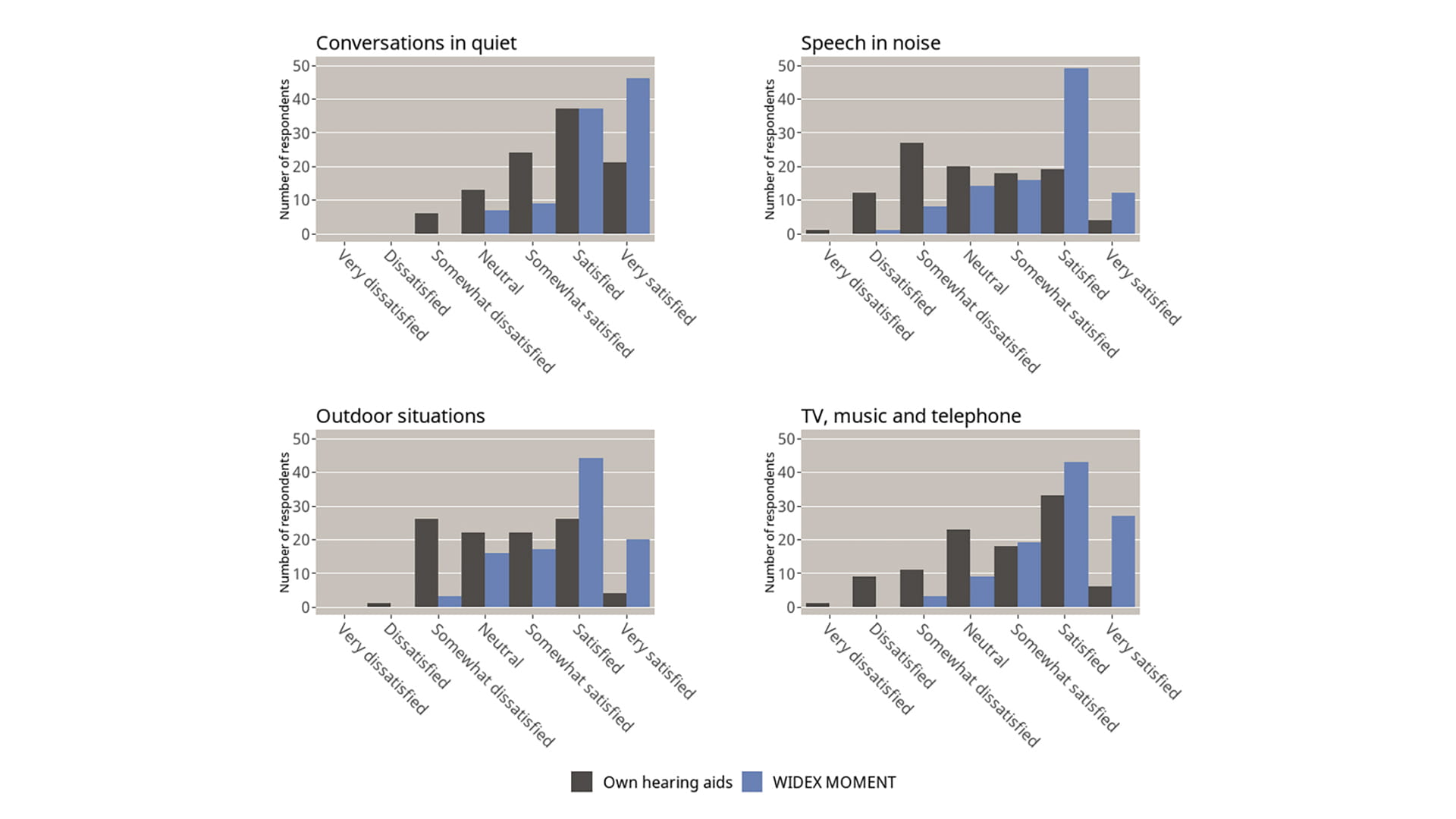
MOMENT sound quality data in real life - not just for experts
Sound quality plays a key feature for overall hearing aid satisfaction as well as in everyday moments of real-life hearing. A large international survey of hearing aid users confirms the importance of sound quality, showing higher satisfaction with the WIDEX MOMENT™ hearing aids for overall sound quality, for specific situations of real-life use and for hearing aid users’ ability to participate in daily life.
Created Updated
As one of the major global hearing aid manufacturers, Widex has a long history of focusing on sound quality, designing all signal processing with the aim of achieving the best and most natural sound quality possible. For example, True Input Technology, with a linear transfer function up to 113 dB SPL and a linear input dynamic range of 108 dB SPL, was groundbreaking when launched,1 as was Variable Speed Compression, which offers the benefits of both slow and fast-acting compression.2
Most recently, WIDEX MOMENT™ launched with the focus on sound quality expressed in two main features:
- TruAcoustics™ is an intelligent algorithm by which the acoustics in the individual ear canal is integrated in the parameter settings of the hearing aid, so the output at the eardrum is exactly right for the individual ear canal with the specific earware choice.3
- Widex PureSound™ drastically reduces hearing aid delay and eliminates the delay-based distortions which are characteristic of other digital hearing aids.4
Innovations like these improve the sound quality in clearly audible ways and result in sound quality preferences in studies, such as the one reported by Balling et al.4 However, it is also an important assumption of the Widex design philosophy that good sound is not an isolated quality but a means to achieving higher hearing aid satisfaction across many situations in real life. With this broader view of sound quality, it is arguably the most important parameter for hearing aid satisfaction, along with speech understanding (especially in noise).
For these reasons, the survey reported below focused on satisfaction with sound quality in itself, as well as the experience in diverse situations of real-life hearing with Widex MOMENT hearing aid.
Survey Method
Our survey included 101 experienced hearing aid users recruited at local hearing clinics in 7 countries (US, Canada, China, Germany, France, Portugal, UK). They all wore the MOMENT mRIC R D rechargeable hearing aids and rated their satisfaction with them in comparison to their own existing hearing aids, which were from all major brands. Respondents were 60% male with a median age of 66 years (range 18-88). Close to half (45%) were work active, and they had a median of 6 years’ hearing aid experience (range 1-59 years).
Respondents fell into two groups: 39 of them had mild-to-moderate hearing losses going from 40 dBHL at low frequencies to 70 dBHL at high and had as their primary program PureSound™, which is particularly suitable for open fits and milder losses. The other 62 respondents had hearing losses up to 80 dB HL across frequencies (the mRIC M-receiver fitting range) and were fitted with the Universal program as their primary program. The MOMENT hearing aids were fitted with the ear tip recommended in the Compass GPS fitting software.
The survey used a cross-over design where respondents started a 7-week survey period by rating their satisfaction with their own existing hearing aids before being fitted with the MOMENT hearing aids and wearing them for 3 weeks. After 3 weeks, they rated their satisfaction with the MOMENT devices, before switching back to their own hearing aids, wearing those for 2 weeks and rating them at Week 6. For the final 2 weeks of the survey, respondents wore MOMENT and filled in a final set of questions about those at Week 7. This resulted in two ratings for own hearing aids (at Weeks 0 and 5) and two for MOMENT (at Weeks 3 and 7).
The questionnaires were filled in online using SMART-TRIAL software, using a format inspired by the MarkeTrak surveys,5 where respondents rate their satisfaction with their hearing aids on a 7-point scale ranging from “Very dissatisfied” (a rating of 1) to ‘Very satisfied’ (a rating of 7). Following the MarkeTrak approach, respondents who gave ratings in the top-3 satisfaction categories may be classified together as being “satisfied.” We asked questions about satisfaction both in general and in specific real-life situations.
The responses show that people are reasonably satisfied with their own hearing aids at the beginning of the survey period, but once they try the MOMENT hearing aids, their ratings of their own hearing aids in many cases become significantly lower. This in itself is evidence in favor of the MOMENT devices. However, the more interesting direct comparison is between the ratings of own hearing aids in Week 5 and MOMENT in Week 7, where respondents have had the most time to form an opinion about the new hearing aids.
We also estimated the age of the respondents’ own hearing aids based on the launch date of the device. Interestingly, we found no significant effects of this variable, indicating that the MOMENT advantages that we observe throughout are not simply explained by the contrast between older own hearing aids and new MOMENT devices, but by a genuine preference for the MOMENT sound.
Unless otherwise indicated, statistical testing of results was done using mixed-effects models that take into account the crucial fact that we have multiple responses per person. The significance levels for the relevant contrasts between own and MOMENT hearing aids are all below 0.0001, which means that potential concerns about repeated testing are unfounded.
Sound Quality Across Situations
As we would expect given the Widex design focus, the responses show a solid sound quality advantage for the MOMENT hearing aids, with significantly higher satisfaction for MOMENT than for own hearing aids (p < 0.0001). Looking at the average ratings plotted in the left panel of Figure 1, there is a 1-point advantage for MOMENT, with the average rating “Satisfied” for MOMENT and “Somewhat satisfied” for own hearing aids. Examining the distribution of answers in the right panel of Figure 1, we see many more “Very satisfied” and “Satisfied” MOMENT users. In total, considering the top-3 satisfaction categories, 91% of respondents are satisfied with the MOMENT sound quality.
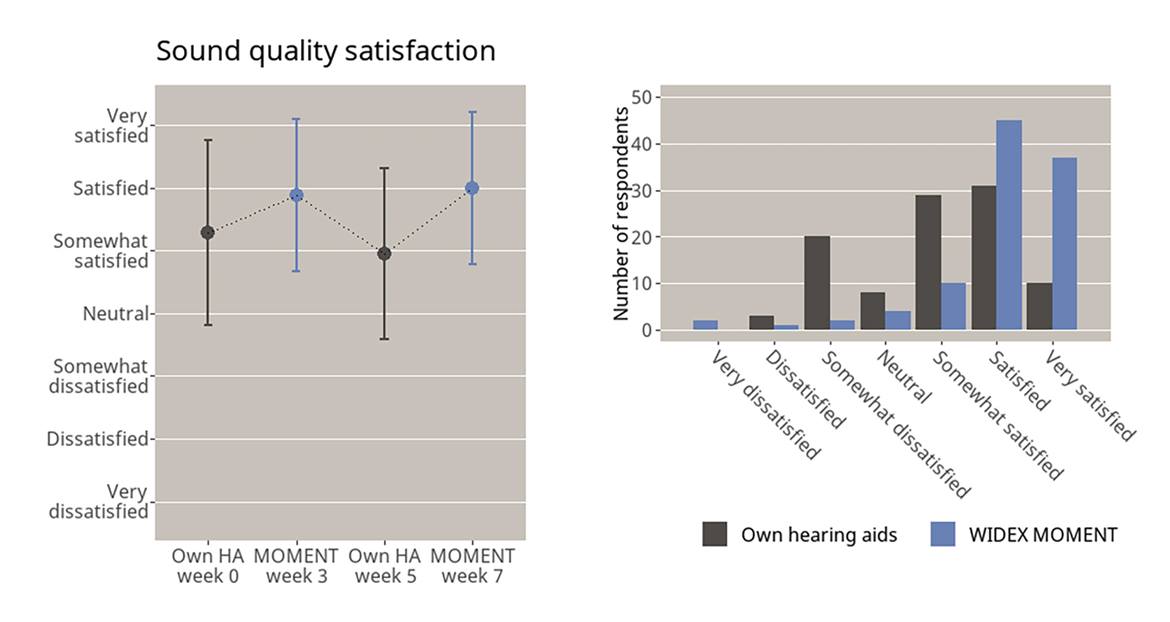
Figure 1. Ratings of satisfaction with sound quality. The left panel shows mean ratings of satisfaction with sound quality as filled circles, with the whiskers representing ±1 standard deviation (SD) around the mean. The right plot shows ratings of own hearing aids in Week 5 and of MOMENT hearing aids in Week 7 of the survey.
An intriguing question is which aspects of sound and hearing aid use influence these high-satisfaction sound quality ratings. This is a complex issue that this survey cannot fully address, but it is informative to look at which other questions are correlated with sound quality satisfaction. In Table 1, such correlations are listed for the ratings of MOMENT at the end of the survey period. They are all strong correlations ranging between 0.522 to 0.698, and although there is some variation between individual situations, the correlations are all highly significant and of similar size. These correlations do not, of course, indicate causation but do suggest that sound quality plays a similar role across different situations.
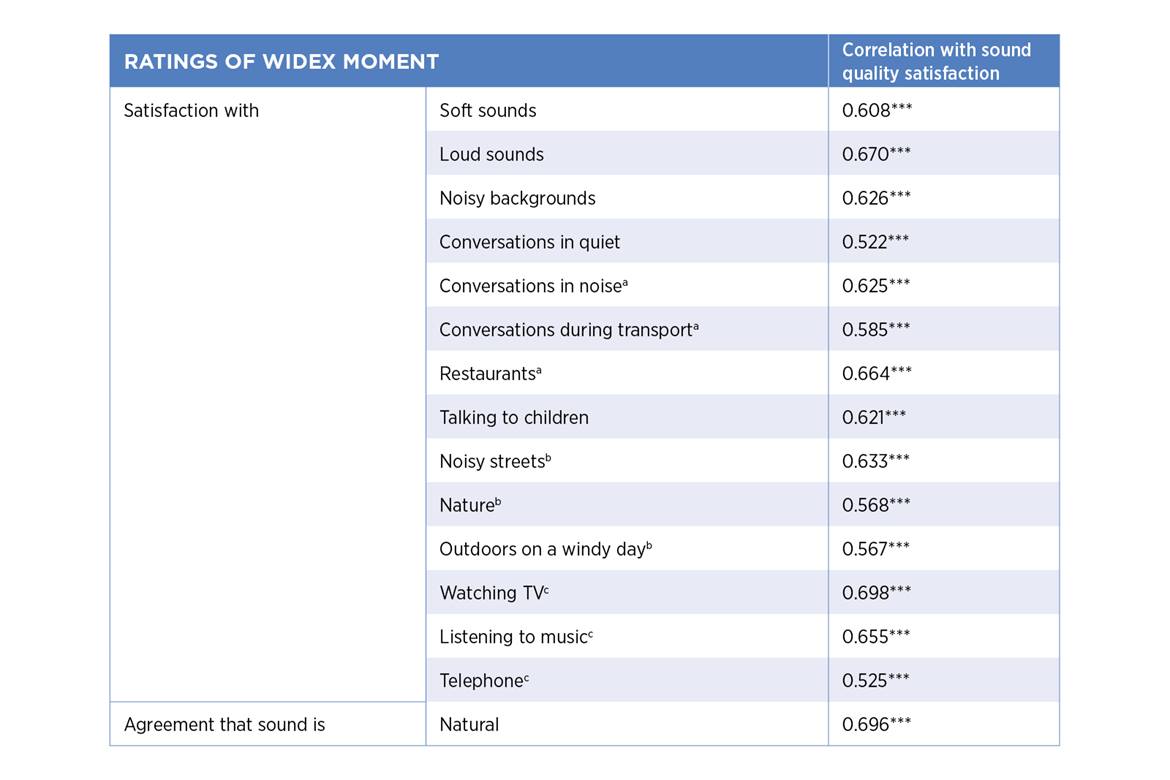
Table 1. Spearman Rho correlations between sound quality satisfaction and satisfaction in specific situations for WIDEX MOMENT. (Notations: *** indicates significance at the p<0.001 level; a) Speech-in-noise situations; b) Outdoor situations; c) Listening through devices.
Another way of assessing the impact of sound quality on everyday satisfaction with hearing aids is analyzing the average satisfaction across the specific situations listed in Table 1 (excepting satisfaction with soft and loud sounds, which are not specific situations). A regression model shows that satisfaction with sound quality is a highly significant predictor of mean satisfaction across situations, accounting for more than 50% of the variance in satisfaction across situations (R2 = 0.51).
Sound Quality and Naturalness
In addition to the different listening situations, Table 1 also lists respondents’ agreement with the statement “I find that the sound is natural with the MOMENT hearing aids” on a 7-point scale. This shows one of the highest correlations with sound quality satisfaction, which means that those hearing aid wearers who are highly satisfied with the sound quality also perceive the sound as more natural.
In addition, naturalness ratings show a very similar pattern across weeks to sound quality satisfaction, as illustrated in Figure 2. Again, we see approximately a 1-point difference between the ratings of own and MOMENT hearing aids, and many more who “Agree” or “Strongly agree” that the sound of MOMENT is natural.

Figure 2. Ratings of naturalness of sound, with the left panel showing mean ratings per week and the right panel showing ratings for own hearing aids in Week 5 and for MOMENT in Week 7.
Satisfaction in Everyday Situations
As seen in Table 1, the survey included questions on a wide range of everyday situations. In Figure 3, these are grouped into four different more general categories, showing the distribution of ratings in Week 5 (own hearing aids) and Week 7 (MOMENT hearing aids).
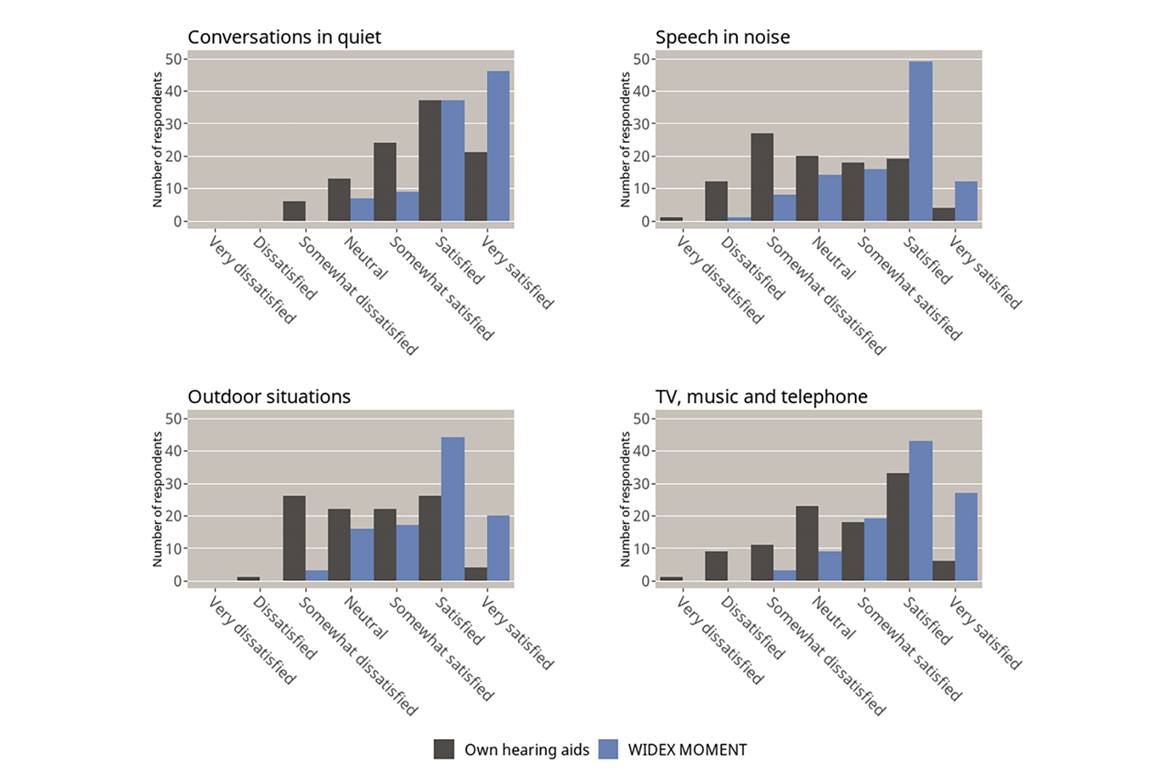
Figure 3. Histograms showing distribution of ratings in Weeks 5 (own hearing aids) and 7 (MOMENT hearing aids).
The top-left panel shows the satisfaction with conversations in quiet, assessed by a single question. Level of satisfaction is generally high, as we would expect for this relatively easy listening environment. However, although the baseline is already high, the MOMENT ratings are still higher, with the most frequent response being “Very satisfied” and the difference to own hearing aids being highly significant (p < 0.0001).
Speech-in-noise ratings are shown in the top-right panel, based on a mean across questions on satisfaction in restaurants and with conversations in noise and during transport. These tend to be difficult situations for hearing aid users, which is also clear if we compare the general level of satisfaction with speech in quiet. This makes the significant advantage for MOMENT (p < 0.0001) all the more noteworthy: the most frequent mean rating for these questions is clearly in the “Satisfied” category for MOMENT, whereas ratings for own hearing aids are more spread out, with “Somewhat dissatisfied” as the most frequent. If we compare the own-vs-MOMENT hearing aid ratings per respondent, five times as many respondents are more satisfied with the MOMENT hearing aids compared with their own: 74% of respondents are more satisfied with MOMENT, 12% more satisfied with their own, and the remaining 14% give the same ratings to both.
The bottom left panel illustrates mean ratings in outdoor situations, again with a markedly differently distribution of ratings for own and MOMENT hearing aids (p < 0.0001). Part of the explanation for the MOMENT advantage could be that respondents experience the sound of MOMENT as more natural, something that is likely to play a larger role outdoors.
The final panel of Figure 3 represents the frequent listening situations where sound comes from a device, with TV likely being the most frequent for most people, but also telephone and music. As for conversations in quiet, the general level of satisfaction is higher here than for more difficult listening situations, but the MOMENT advantage remains, with a significant difference to own hearing aids (p < 0.0001). Collectively, the four types of situations illustrated in Figure 3 give a comprehensive view of the everyday lives of hearing aid users, and across all these situations MOMENT shows a solid advantage.
Participation in Daily Life
A common problem for people with hearing loss, reported both scientifically6,7 and by hearing aid users and their relatives to HCPs all over the world, is the difficulty of participating in everyday life. Therefore, the survey included a question inspired by the International Outcome Inventory for Hearing Aids (IOI-HA)8: “How satisfied are you with your ability to participate effortlessly in everyday life with [your own hearing aids/the WIDEX MOMENT hearing aids]?” The ratings for this question are shown in Figure 4, where both plots illustrate a similar 1-point MOMENT advantage that was also seen previously (p < 0.0001). An interesting statistic is how many people are satisfied (in the top-3 categories) with their ability to participate in everyday life; this number is 69% for own hearing aids but 90% for MOMENT. Conversely, only 6% of respondents indicate dissatisfaction with participation when wearing MOMENT, while the corresponding number is 20% for own hearing aids, in spite of the fact that the MOMENT devices are new to the respondents and they cannot be expected to be completely habituated to them yet.
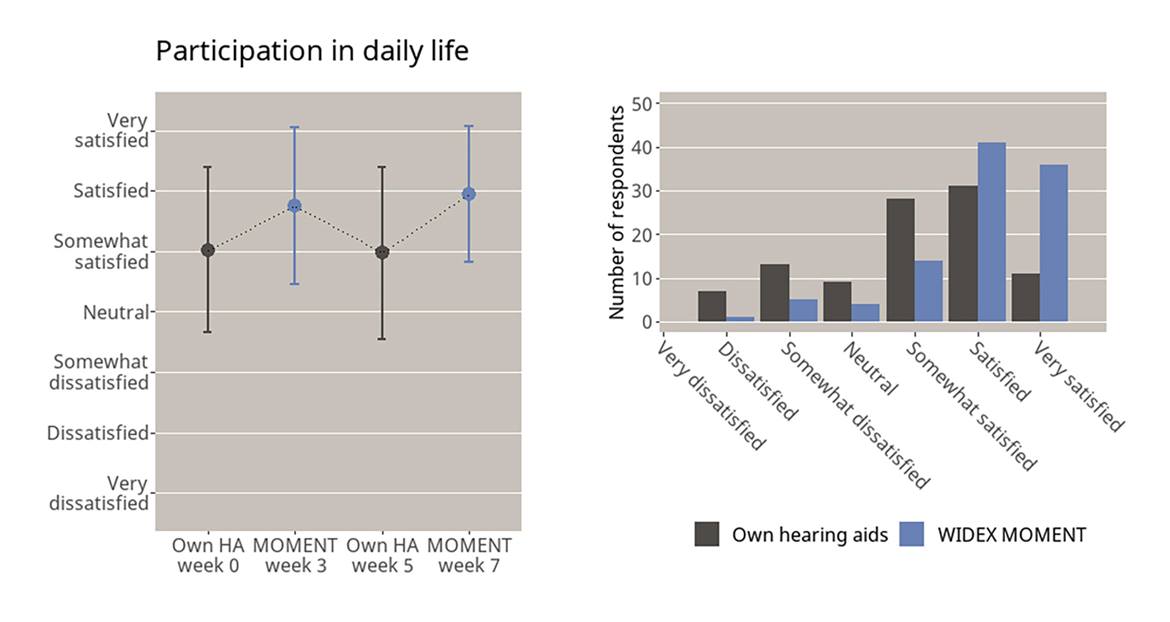
Figure 4. Ratings of ability to participate in everyday life, with the left panel showing mean ratings per week and the right panel showing ratings for own hearing aids in Week 5 and for MOMENT in Week 7.
Overall Satisfaction
Finally, a question about overall satisfaction examines how all these different elements of real-life hearing come together in the respondents’ entire experience of wearing the MOMENT hearing aids, compared with their own. The responses to this question were tested in the same way as previous results, showing significantly higher ratings (p < 0.0001) for MOMENT than own hearing aids. The left panel in Figure 5 is a particularly clear example that respondents’ ratings of their own hearing aids change when they have tried MOMENT, as evidenced by the lower ratings in Week 5 compared to Week 0. More generally, Figure 5 confirms the MOMENT advantage that has also been clear in the more detailed questions, with the most frequent overall response to the MOMENT hearing aids being “Very satisfied.”
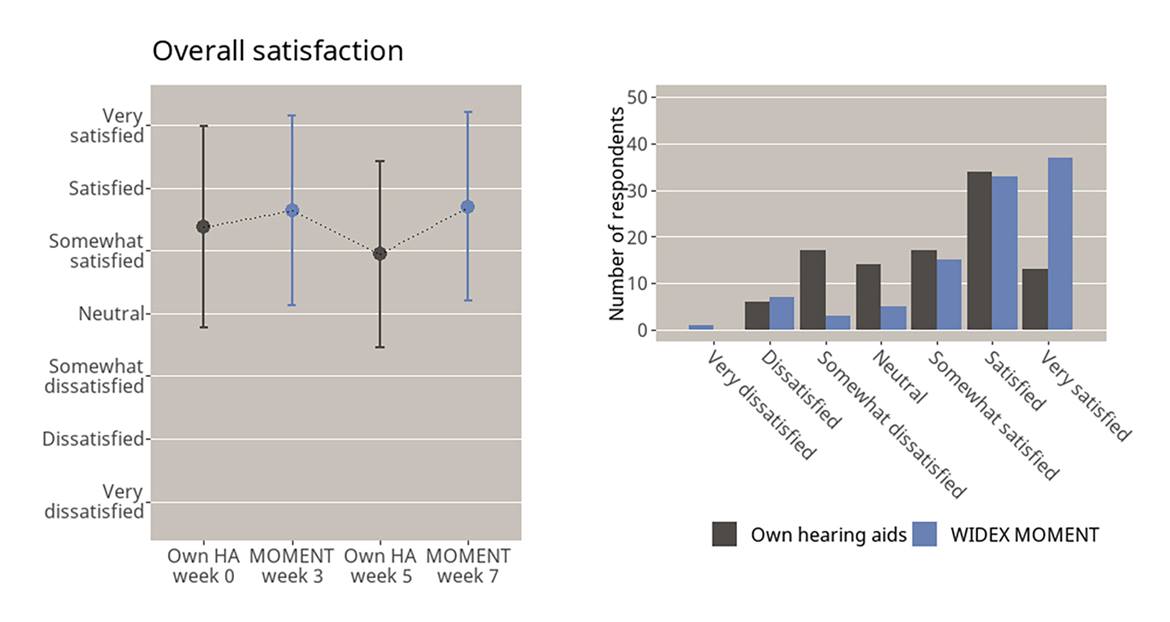
Figure 5. Ratings of overall satisfaction, with the left panel showing mean ratings per week and the right panel showing ratings for own hearing aids in Week 5 and for MOMENT in Week 7.
The Importance of Sound Quality in Real Life Hearing Aid Use
The results reported in this article show the importance of sound quality in many different moments of real life, confirming the Widex design philosophy that sound quality should be central. We see solid advantages for the MOMENT devices for sound quality satisfaction in general, as well as for ratings of a representative selection of real-life situations, and for the key factor of participation in daily life.
The results also show that sound quality should not be seen as a quality for experts only. The respondents in this survey were not selected to have a specific focus on sound quality; they represent a broad group of hearing aid users, with different lives and different (hearing) needs and wishes. Nonetheless, the results support the importance of sound quality, both as an overall phenomenon and as a continually relevant factor in many different situations of real-life hearing for many different people. So, although Widex does aim to fulfill the needs of musicians and other sound experts with great-sounding hearing aids, the target group is not limited to connoisseurs: the great sound quality of WIDEX MOMENT™ benefits everyone.
Acknowledgements
We are grateful to all hearing aid users and hearing care professionals for participating. We would like to thank the following clinics for taking part: In the US: Amazing Hearing, Laguna Hills, CA; Associated Audiologists, Shawnee Mission, KS; Bergen Audiology, Hackensack, NJ; ENT Specialist of Abilene, Abilene, TX; Pacific Hearing Service, San Francisco, CA; San Francisco Audiology, San Francisco, CA. In Canada: Audiology Clinic of Northern Alberta, Edmonton, Alberta; Davidson Hearing Aid Centres, Ottawa, Ontario; Harp Hearing, Calgary, Alberta; Lakeside Hearing, Kelowna, British Columbia; North Bay Audiology Clinic, North Bay, Ontario; Owen Sound Audiology, Owen Sound, Ontario; Sackville Hearing Centre, Lower Sackville, Nova Scotia; Sound id-EARS, Vancouver, British Columbia. In China: Blue Hearing, Kunming, Yunnan; Conhearing, Zhengzhou, Henan; Conhearing, Haerbin, Heilongjiang; Earhearing, Chengdu, Sichuan; Huier, Hangzhou, Zhejiang; Intelligent Sound, Shanghai; Li Sound, Wuhan, Hubei; Logic Sound, Chongqing; Nordic Sound, Shanghai; Sound of Nature, Shanghai; Sound of Xin, Guangzhou, Guangdong. In Germany: Hesselbach Hörakustik; Hörakustik Tielesch; Hörgeräte Seifert GmbH; Schaaf & Maier Hörgeräte GmbH. In Portugal: Widex Braga; Widex Coimbra; Widex Funchal; Widex Guimarães; Widex Lisboa.
Citation for this article: Balling LW, Townend O, Helmink D. Sound quality in real life–Not just for experts. Hearing Review. 2021;28(2):27-30.
Correspondence can be addressed to Dr Balling at: laba@widex.com.
References
Kuk F, Lau C-C, Korhonen P, Crose B. Evaluating hearing aid processing at high and very high input levels. Hearing Review. 2014;21(3):32-35.
Kuk F, Hau O. Compression speed and cognition: A variable speed compressor for all. Hearing Review. 2017;24(3):40-48.
Balling LW, Jensen NS, Caporali S, Cubick J, Switalski W. Challenges of instant-fit ear tips: What happens at the eardrum? Hearing Review. 2019;26(12):12-15.
Balling LW, Townend O, Stiefenhofer G, Switalski W. Reducing hearing aid delay for optimal sound quality: A new paradigm in processing. Hearing Review. 2020;27(4):20-26.
Powers TA, Rogin CM. MarkeTrak 10: Hearing aids in an era of disruption and DTC/OTC devices. Hearing Review. 2019;26(8):12-20.
Scarinci N, Worrall L, Hickson L. The effect of hearing impairment in older people on the spouse. Int J Audiol. 2008;47(3):141-151.
Ciorba A, Bianchini C, Pelucchi S, Pastore A. The impact of hearing loss on the quality of life of elderly adults. Clin Interv Aging. 2012;7:159-163.
Cox R, Hyde M, Gatehouse S, et al. Optimal outcome measures, research priorities, and international cooperation. Ear Hear. 2000;21(4):106S-115S.